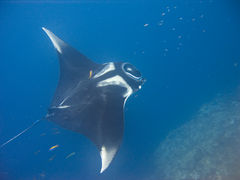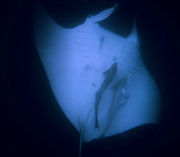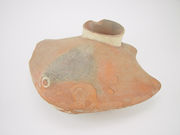Manta ray
| Manta ray Fossil range: 23–0 Ma[1] Early Miocene to Present |
|
|---|---|
 |
|
| Manta ray at Hin Daeng, Thailand | |
| Conservation status | |
|
Near Threatened (IUCN 3.1) |
|
| Scientific classification | |
| Kingdom: | Animalia |
| Phylum: | Chordata |
| Class: | Chondrichthyes |
| Subclass: | Elasmobranchii |
| Order: | Myliobatiformes |
| Family: | Mobulidae |
| Genus: | Manta Bancroft, 1829 |
| Species: | M. birostris |
| Binomial name | |
| Manta birostris (Walbaum, 1799) |
|
The manta ray (Manta birostris) is the largest species of the rays. The largest known specimen was more than 7.6 metres (25 ft) across, with a weight of about 2,300 kilograms (5,100 lb). It ranges throughout tropical waters of the world, typically around coral reefs. They have the largest brain-to-body ratio of the sharks, rays and skates (Elasmobranchii).[2]
Mantas have a variety of common names, including Atlantic manta, Pacific manta, devilfish, and just manta. At one time it was thought that there were many species of Manta. However, the modern scientific consensus has been that there is just one species,[3] a view supported by mitochondrial DNA studies.[4]
Recent studies have suggested that manta rays actually comprise at least two different species, the giant manta (Manta birostris), which migrates, and another smaller one called the reef manta (Manta alfredi), which does not.[5][6][7] The use of the "alfredi" name is questionable. The species alfredi was first used in the description of Prince Alfred's manta ray by Krefft in 1868.[8] [9] Modern genetic studies have shown that Ceratoptera alfredi (Krefft, 1868), revised as Manta alfredi (Krefft, 1868), is a synonym of Manta birostris (Donndorff, 1798). The genus is generally considered to be in need of worldwide revision. Even the accepted name Manta birostris is often incorrectly ascribed to Walbaum (1792).
Contents |
Evolution and taxonomy
Manta rays may have evolved from bottom-feeders, and then adapted to become open ocean filter feeders. This feeding strategy allowed them to grow larger than other ray species. Some ancestral characteristics degenerated due to the feeding change. For example, all that remains of the oral teeth is a small band of vestigial teeth on the lower jaw, almost hidden by the skin. The number and size of their dermal denticles are also reduced. Manta rays have a much thicker mucus body coating than other rays. Their spiracles have become small and non-functional, as all water is consumed orally. Mantas have a tail similar to Stingrays, but they have lost their sting and are harmless to divers.[10]
Behavior

Mantas feed on plankton, fish larvae and the like, filtered from the water passing through their gills as they swim. They catch small prey organisms on flat horizontal plates of russet-colored spongy tissue spanning spaces between the manta's gill bars.
Manta rays frequent cleaning stations where small fish such as wrasse, remora, and angelfish swim in the manta's gills and over its skin to feed, in the process cleaning it of parasites and dead tissue.
Large sharks and in some circumstances orcas, are manta's main predators.
Mantas display curiosity around humans, and swim among divers. They often surface near boats with stopped engines.
Mantas breach the surface and launch into the air.
Mantas can swim 7 miles per hour.[11]
The breeding behaviour observed for manta rays is similar to other closely related rays. Copulation occurs near the surface, no deeper than a metre below. It begins with the male chasing the female, for up to half an hour. The male bites the pectoral fin and then moves its claspers into the cloaca, holding it there for a minute to a minute and a half.[12]
In culture

The ancient Peruvian Moche people worshipped the sea and its animals. Their art often depicts Manta rays.[13] Not knowing about their gentle nature, two 1930s movies played on the manta's "fearsome" appearance: 1930's The Sea Bat, starring a pre-Frankenstein Boris Karloff, and 1936's The Sea Fiend, later re-issued as the 1946 Devil Monster.
In 2009, SeaWorld Orlando debuted Manta, a flying roller coaster themed to resemble the manta ray, along with an exhibit featuring other ray species.
The American alternative rock band Pixies has also recorded songs called "Manta Ray" and "Dancing the Manta Ray." In 2010, the alternative band Ludo released a song titled "Manta Rays."[14]
In captivity
Manta rays are very rarely kept in captivity, primarily due to their size. Only five aquariums in the world display manta rays.[15] One notable example is "Nandi", a manta ray that was accidentally caught in shark nets off Durban, South Africa in 2007. Rehabilitated, and outgrowing her aquarium, uShaka Marine World, Nandi moved to the larger Georgia Aquarium in August 2008, where she resides in its 6.2-million-gallon "Ocean Voyager" exhibit. A second manta ray joined that Aquarium's collection in September 2009, dubbed "Tallulah." A third manta ray has recently been added to the Ocean Voyager exhibit.[16]
The Okinawa Churaumi Aquarium also houses manta rays in the "Kuroshio Sea" tank, the second-largest aquarium tank in the world. On June 16, 2007, the first manta ray born in captivity was born at the Aquarium.[17] Although the pup born in 2007 did not survive, the Aquarium has also since seen the birth of two more manta rays in 2008 and 2009.[18]
The Lisbon Oceanarium also hosted a manta ray before releasing it in 2007.
A manta ray was hosted again in 2008. Photo from june 12, 2008.
Gallery
 Manta ray off Ishigaki Island. |
 Manta ray feeding over coral. |
See also
- List of prehistoric cartilaginous fish
References
- ↑ Sepkoski, Jack (2002). "A compendium of fossil marine animal genera (Chondrichthyes entry)". Bulletins of American Paleontology 364: 560. http://strata.ummp.lsa.umich.edu/jack/showgenera.php?taxon=575&rank=class. Retrieved 2008-01-09.
- ↑ "Manta Rays". The Hawaii Association for Marine Education and Research, Inc.. 2005. http://www.hamerinhawaii.org/Main%20Web%20Pages/Education/Marine%20Life/Rays/manta_rays.htm. Retrieved 2007-12-09.
- ↑ Last, P.R.; Stevens, J.D. (1994). Sharks and rays of Australia. Melbourne, Australia: CSIRO. ISBN 0643051430.
- ↑ Clark, Timothy Brian (2002). Population Structure of Manta birostris (Chondrichthyes: mobulidae) from the Pacific and Atlantic Oceans (MS thesis). Texas A & M University. OCLC 52083914.
- ↑ "Manta Rays: A new species?". Save Our Seas Foundation. http://www.saveourseas.com/manta-rays-a-new-species.
- ↑ http://www.bbc.co.uk/nature/species/Manta_ray#p0052vwz
- ↑ "Manta Ray Research". Foundation for the Protection of Marine Megafauna. http://marinemegafauna.org/mantarays/. Retrieved 2010-05-12.
- ↑ "Manta". Florida Museum of Natural History. http://www.flmnh.ufl.edu/fish/gallery/Descript/MantaRay/MantaRay.html. Retrieved 2009-11-11.
- ↑ Whitley GP (1936). "The Australian devil ray, Daemomanta alfredi (Krefft), with remarks on the superfamily Mobuloidea (order Batoidei)". Australian Zoologist 8 (3): 164–188.
- ↑ Manta Ray (Manta birostris) FAQ
- ↑ "Pacific Manta Ray". theBIGzoo. 2009. http://www.thebigzoo.com/Animals/Pacific_Manta_Ray.asp. Retrieved 2009-12-27.
- ↑ Yano, Kazunari; Sato, Fumihiko; Takahashi, Tomoko (September 1999). "Observations of mating behavior of the manta ray, Manta birostris, at the Ogasawara Islands, Japan". Ichthyological Research 46 (3): 289–96. doi:10.1007/BF02678515.
- ↑ Berrin, Katherine (1997). The Spirit of Ancient Peru:Treasures from the Museo Arqueológico Rafael Larco Herrera. New York: Thames and Hudson.
- ↑ "Ludo: Album: Prepare the Preparation". Island Def Jam Music Group. http://www.ludorock.com/discography/detail.aspx?pid=12336. Retrieved 2009-11-11.
- ↑ "About Nandi". Georgia Aquarium. http://www.georgiaaquarium.org/nandi/about-nandi/. Retrieved 2008-08-27.
- ↑ Andres, Bob (2009-09-03). "Second manta ray at Georgia Aquarium". The Atlanta Journal-Constitution: p. A1.
- ↑ "The birth of Manta Ray in the tank, for the first time in the world!". Okinawa Churaumi Aquarium. http://www.kaiyouhaku.com/en/news/07061701_01_report.html. Retrieved 2009-12-12.
- ↑ "3 Years in a row!". Okinawa Churaumi Aquarium. http://www.kaiyouhaku.com/en/news/09092801_01_info.html. Retrieved 2009-12-12.
External links
- Microdocs: Manta ray
- Manta Ray videos and news stories from the BBC including footage of the possible new species
- Manta birostris, IUCN Red List of Threatened Species